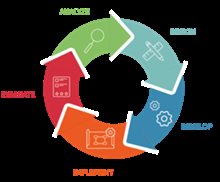Training need analyses, course design and development.
Training life cycle
The Training Needs Analysis phase stands out as the most crucial and challenging aspect of the training life cycle. Participants often find it challenging to pinpoint precisely where they lack knowledge.
ADDIE Model
World Water Academy uses the Instructional Systems Design model ADDIE to design, develop and deliver applicable and practical training programmes. All learning activities are developed by a group of experts, consisting of a didactical expert and professionals working in the field of the course topics.
The ADDIE model consists of the following steps:
The Analyse step starts with an analysis of the target group, their prior knowledge and their learner characteristics. Then we define the set of Knowledge, Skills and Attitude (K+S+A) of the different competences needed by the target group the learning objectives.
The Design step creates the outline of the full programme, based on the analysis of the target group and the learning objectives. The outline combines the main topics, needed time, learning objectives, teaching methods, needed materials, work practise and assignments.
In the Development step the materials are developed, including the trainers guide, exercises, course books, practical assignments, presentations, and digital content.
The Implementation step is the rollout of the programme. The learning activities are facilitated by seasoned professionals/ subject matter experts who have undergone trainer training and are well-prepared to deliver the course. They always receive support from didactical experts at World Water Academy.
The Evaluation step involves assessing participant satisfaction and gauging the effectiveness of the learning activity in collaboration with trainers. The feedback obtained from this evaluation is utilized to make adjustments to the program before its subsequent delivery.



